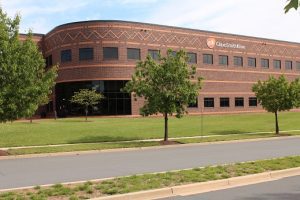
Designing for Cell and Gene Therapy Facilities
Q&A with Grace Linton, Process Architect
January 20, 2019
Cell and gene therapy companies are ushering in a new frontier of medicine and technologies poised to revolutionize human health. The industry is advancing at such a rapid pace that these companies are faced with vast new complexities when developing and manufacturing their products.
The BioHealth Capital Region, Maryland, Virginia and Washington D.C., has become a burgeoning hub for cell and gene therapy with companies like American Gene Technologies Inc., BeneVir Biopharm Inc., Immunomic Therapeutics Inc. and REGENXBIO, as well as companies, such as Kite Pharma and Autolus Therapeutics that have recently moved to Maryland. Many of these companies have amassed here to leverage a robust talent pool, proximity to unmatched research assets at institutes, such as National Institutes of Health and National Cancer Institute, universities, such as Johns Hopkins University and the University of Maryland, and the Food and Drug Administration. Dedicated investment programs, such as the Maryland Stem Cell Research Fund has also fueled purposeful innovation and local commercialization in this sector.
To succeed in this field, this new breed of biotechnology companies needs to understand and reimagine almost everything in their operation—from supply chain and logistics to workflow, manufacturing, quality, safety, and labor. Each of these components impacts facility design and engineering. It’s such a new industry that many processes haven’t even been developed, making it all that more challenging for companies to navigate their growth.

To dig deeper into this topic, we reached out to CRB’s process architect, Grace Linton, RA, AIA, LEED AP BD+C, who has been involved in designing commercial manufacturing facilities for multiple cell and gene therapy companies. CRB is a global engineering, architecture, construction and consulting firm that specializes in biopharma and life sciences industries. With 35 years of experience and a strong local reputation, CRB’s Rockville team has become an important resource for the growing cell and gene therapy companies in the BioHealth Capital Region. While the growing hub in this region wasn’t defined until a couple of years ago, CRB’s first cell and gene therapy project was over 20 years ago!
We sat down with Grace to learn more about her design process and the unique challenges many of her client’s face.
***
Q: Could you tell us a bit about how you joined CRB and the Rockville office?
A: I was offered an opportunity to interview with CRB’s St. Louis team during my last year at Washington University in St. Louis. Wanting to be closer to family, I moved back to California after graduation and joined CRB’s San Jose office. This gave me the opportunity to learn directly from two industry leaders, Mark von Stwolinski, CRB’s vice president of facility integration and lead concept process architect, and Mike Wilson, architect and architectural discipline lead of CRB’s Emeryville office. Mark and Mike taught me what it takes to become a licensed, process architect—from building codes to Current Good Manufacturing Practice (CGMP) regulatory requirements. When CRB opened its Rockville office in 2014, I was the first employee to join Matt Khair, the office leader.
Q: What was it like learning process architecture from Mark von Stwolinski?
A: It was so much fun to travel the world and design facilities! But it also required a lot of intellectual rigor—from reading pages and pages of guidance documents (good nighttime reading, according to Mark) to leading design workshops where we conceptualized a facility design that addressed hundreds of different factors and drivers. I learned the ins and outs of designing CGMP commercial manufacturing facilities and how all the pieces needed to fit together.
Q: What exactly is a process architect?
A: We’re a rare breed of architects. First and foremost, we’re licensed architects who are well versed in building codes, building systems and materials, and architectural design. We are trained to think spatially and consider the human experience of the environment we create. What distinguishes process architects is their understanding of process, operational and regulatory requirements and knowledge of equipment and technology. CGMP commercial manufacturing facilities are very complex buildings. Borrowing the “form follows function” principle, I would argue that architects can’t design a good production building (form) without a deep understanding of the process (function) that takes place inside.
Q: How does process architecture benefit cell and gene therapy companies in particular?
A: Since the industry is in its early stages, many of the processes are new and still under development. In addition, fully automated, closed processing equipment options are limited. As a result, manual, open processing is common, and the room environment becomes the layer of protection for the product. This translates to high classification of spaces and a long list of design considerations, such as proper wall thicknesses for low-wall returns, properly sized gowning rooms for different levels of required gowning, special finishes and details compatible with cleaning solvents, decontamination methods and so much more.

Another value that cell and gene therapy companies could gain from the early involvement of a process architect is properly planning the facility for scaling out. Autologous and personalized therapies, for example, require each batch to be dedicated to one patient. For these facilities, the only way to increase production is to scale-out by adding more production trains or suite modules. Circulation and egress strategies for multiple suites at full build-out must be established upfront. Sizing support spaces like the locker rooms and setting the corridor widths for supporting operations at full production mode is also critical.
The other challenging variable that I’m often tasked with for cell and gene therapy companies is to accommodate future-proof design.
Q: What do you mean by “future-proof design”?
A: As new technology comes out and processes are automated, it will allow for more closed processing. This will make things much less complicated for regulations and for facility design and operations. Equipment technology for process closure will be a game changer in the near future. When this occurs, allocation of space will change, which I need to take into account in my design. For example, a recent project required Grade B processing suites because of a few open unit operations that couldn’t be closed with existing equipment technology. But once the closed processing equipment technology becomes available, this facility could change quite drastically—from removing air locks to potentially converting from unidirectional flow to bidirectional flow. Anticipating these changes, I try to design the hallways, production suites and surrounding areas in a way that would provide maximum flexibility/minimal impact during a renovation.
Q: What other design challenges are unique to cell and gene therapy facilities?
A: There is a wide range of products within the cell and gene therapy industry, and each product type comes with its unique challenges, such as containment and segregation strategies for viral vector production and heavy use of liquid nitrogen for cryopreservation in cell therapy. In the case of liquid nitrogen, vacuum-insulated pipes for distribution can be very expensive, and poor placement of the liquid nitrogen tanks and cryo freezers could be very costly.
Q: What do you believe makes CRBers stand out?
A: CRB is a very collaborative group of architects and engineers who reflect “the whole is greater than the sum of its parts” philosophy. For instance, I have been working very closely with our operations improvement (OI) team to help our cell and gene therapy clients understand what their facility operations would look like. By combining our OI team’s labor modeling, process simulation studies and warehousing analysis with my facility layout, we can enable our clients to make data-driven decisions.

Individually, we are all hungry to know and understand the science and to do things for the right reasons. We are all self-motivated, intellectual individuals who want to push the limits of science and engineering and be trailblazers. We strive for innovative and value-added solutions that go beyond our clients’ expectations.
Q: What do you love about your work?
A: Where do I start? I love the challenge of that first design: Translating nebulous concepts into a physical form. Architecture is a visual, universal language. When people see a drawing, they intuitively understand what they’re seeing. That’s always been my personal intrigue and fascination with architecture as an art form.
I love creative problem-solving. Conceptualizing a production facility is like solving a complex puzzle. I find joy and satisfaction in designing a facility that combines a myriad of factors: client process and programming requirements, site requirements, structural considerations, facility-specific information, building codes, life-safety considerations, regulatory requirements, utility systems and so on into a cohesive, elegant solution.
Lastly, I feel honored to play a role in this exciting field that is focused on saving and improving the lives of people. As someone who is all too familiar with the pains and losses caused by illnesses, I am personally driven to dedicate my best work toward producing important cures and therapies that save lives. In the end, that’s what matters most.
Q: Finally, what closing advice do you have for companies that are about to start a new facility design project?
A: Begin with the end in mind. Especially for cell and gene therapy products that are on a fast-track path to market, it is critical to have a clear vision and goal for the project and build a team that shares this vision and works toward the same goal. Bring all of the right people together for the early design meetings, especially a process architect. The right design firm will contribute significantly, even pushing back on your design layouts, in order to give you what you need to be successful and meet regulatory requirements, not just what you ask them to design.
Visit CRB to learn more about their cell and gene therapy facility services and their expert staff, such as Grace.

- About the Author
- Latest Posts
Over the past 11 years, Chris has grown BioBuzz into a respected brand that is recognized for its community building, networking events and news stories about the local biotech industry. In addition, he runs a Recruiting and Marketing Agency that helps companies attract top talent through a blended model that combines employer branding and marketing services together with a high powered recruiting solution.




